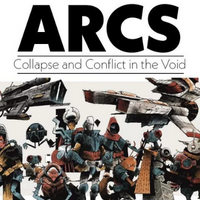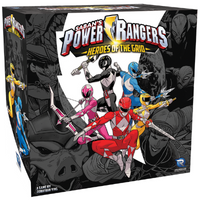01 November 2022
|
Write for the galaxy in Twilight Inscription
Twilight Imperium is 25 years old this year. The first edition of the game landed in 1997 with the iconic ‘wonky cat-lion-man’ on the cover, and subsequent editions make improvements on the game itself (and the lion-man, who becomes less wonky, and wiser looking) to the point where Twilight Imperium Fourth Edition happily sits at number six in the Board Game Geek top 100. Famous for its lengthy play times, faction powers, and full on space 4X experience. The word is, if you want to get exploring, expanding, exploiting and exterminating this is the real deal (if you can get everyone to commit for a whole day).
How then, could we possibly see this turned into a quite accessible roll and write game? Surely it can’t all fit on one of those little pads? Well, no, actually, you’re going to end up with four different
We turn to the game’s designer, James Kniffen to find out.
Hey, who are you?
James Kniffen: I’m James Kniffen, a senior game designer at Fantasy Flight Games, where I’ve been making expansions and new games for over a decade now. I’m probably best known for Forbidden Stars or Star Wars: Armada.
Tell us about Twilight Inscription?
JK: Twilight Inscription is a roll and write game for one to eight players. It’s set in the same universe as the Twilight Imperium board game, a sci-fi setting full of dramatic action and distinctive species. Each player guides one of the galaxy’s factions to greatness via gameplay inspired by the 4X game genre. The player who maximizes their strategic opportunities while defending against the predations of their neighbours will gain the most victory points, establishing their faction as the undisputed leader of the galaxy.
Twilight Imperium as a roll and write is an amusing idea, where did that start?
JK: I was writing a flurry of pitches for new games at about the time that I was really getting into roll and write games. Though I generally prefer large and complex games (Fields of Arle is a personal favourite), I love a game that elegantly crams a surprising amount of nuance into a simple structure—a quality epitomized by modern roll and write games. They may be small, but they contain big decisions that hit with all the weight and finality of putting pen to paper.
However, another small roll and write game wouldn’t feel very FFG. That meant I had to go big and make it the grandest one I’ve seen yet—and nothing says ‘grand’ like Twilight Imperium.
Is this the first eight-hour roll and write?
I would absolutely play an eight-hour roll and write at least once, someone design that! But no, Twilight Inscription is a much more reasonable two hours or so; not as long as Twilight Imperium Fourth Edition, but definitely still the entrée for an evening of fine gaming.

How do the various boards work and what’s the core loop of the game?
JK: Those sheets you’re seeing? Each player has all four of them. It’s frankly quite a table hog, but you can orient your sheets however you want to suit your table.
The sheets represent your faction’s progress in exploring the galaxy, developing planets, deploying forces, and so forth. Each sheet is inspired by one of the X’s of the 4X game genre. The core loop is driven by event cards that tell the players what kind of round they’ll resolve. Most events provide a few resources which you can spend on one (and only one!) of your sheets—choosing which sheet to spend them on is a delightfully agonizing decision, especially because you have to make that choice before you see what additional resources are rolled on the dice.
Other events have all the players fighting in wars, voting in the Galactic Council, or producing trade goods to spend at a crucial moment. Regardless of the type of event, all play is simultaneous, meaning there is little waiting in this game.
You managed to squeeze in all 24 factions, how do they retain their unique powers? How was that translated?
JK: For each faction, I searched for the mechanical or thematic aspect that most defined their style of play in Twilight Imperium Fourth Edition and tried to recreate that experience. Each faction has a persistent power that reinforces their play style, and they each have a major power that triggers when they acquire a rare asset that appears only once on each sheet. For example, the Embers of Muaat can acquire this asset early to deploy a prototype war sun well before anyone has unlocked war suns.
The tech tree is core to Twilight Imperium – how does that fit on a sheet?
JK: Techs function very similar to how they do in Twilight Imperium, they’re just incorporated into the sheet that they affect. The tech tree is flattened since there are fewer techs in this game, but each tech has a big impact to warrant the investment needed to unlock it. Techs, like most aspects of the players sheets, are tracked with a simple set of marks. You’ll be marking your sheets a whole lot, but the method of marking is easy.
There’s a solo mode, what kind is it?
JK: The solo mode uses an AI sheet that races against you for objectives while also wielding military and political strength against you. It doesn’t ask you to simulate all of a player’s choices (your own sheets will occupy your brain space), but by competing against you, it will interfere with your plans and make it hard to achieve a high score. The AI has multiple difficulty levels, and your goal is to achieve a winning score for that difficulty level. See how many factions you can get the best score with.
What are your hopes for the game?
JK: One of my major goals for this game was replayability. Most roll and write games don’t have an element that creates variety from session to session beyond dice results. I wanted a game that felt different every time from the very beginning, so I made eight variations for each type of sheet—that’s thousands of combinations before faction is even considered. Even if you’re a long-time Twilight Imperium fan who refuses to play any faction other than the Ghosts of Creuss, you can have a novel strategy puzzle each time you play. And if that thought abhors you, we’ve got you covered; there’s also a side on each sheet that has no variance if you want everyone to have identical opportunities.
Looking for more?

This review came from Tabletop Gaming Magazine, which is home to all of the latest and greatest tabletop goodness. Whether you're a board gamer, card gamer, wargamer, RPG player or all of the above, find your copy here.
Get your magazine hereRead More...

If you want to read more about one of the most hotly anticipated games of the year, check out our interview with Cole Wehrle on ARCS! A new game from the designer of Root and Oath, and we've got all you need to know.
To infinity and beyond
Join us in person

We can't wait for Tabletop Gaming Live 2022! An epic weekend in Manchester full of board games, card games, roleplaying games, wargames and more, with amazing exhibitors, great games, and an opportunity to game together in person.
See you there!Treat Yourself!

Have you visited our game store? We have everything from mystery boxes, to games and accessories – including the above Power Rangers: Heroes of the Grid, with a great discount! Head over to find your new favourite game.
Visit the Game Store
Sometimes we may include links to online retailers, from which we might receive a commission if you make a purchase. Affiliate links do not influence editorial coverage and will only be used when covering relevant products








Comments
Login or register to add a comment
No comments